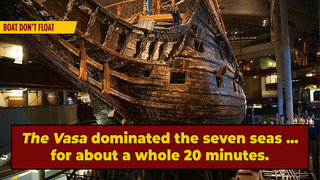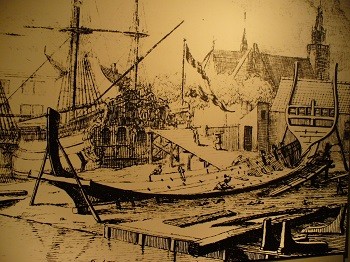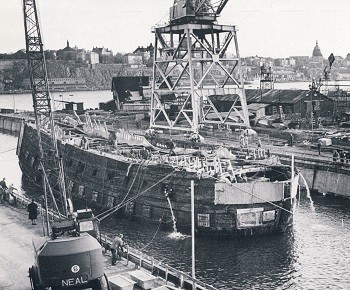Europe's Greatest Warship Was Defeated By A Stiff Breeze

There are few things more terrifying for a European ruler to hear than "the Vikings are at it again." By the early 17th century, Sweden's King Gustav II Adolf had elevated his nation to one of the dominant navies on (or around) the continent. So when the king was told it was time to build more modern ships, he launched the greatest warship of its time. That time being roughly between 4 and 5 PM on a Thursday.
On August 10th, 1628, the harbor of Alvsnabben near Stockholm witnessed the maiden voyage of the Vasa, the new flagship of the Swedish navy. Under the supervision of the king himself, the Vasa was the most impressive warship ever constructed, a 1,210-ton behemoth with 64 canons over two gundecks and a hull and gallery replete with brightly colored sculptures of Roman emperors, Egyptian gods, and even Gustav's ancestors. But none of that pomp and circumstance did it any good when, with less than one nautical mile on its odometer, the flagship had already reached the end of the line and sank.
Don't Miss
What happened to the Vasa was less of a maritime epic of storms and gunpowder and more akin to the Challenger Disaster. After encountering a somewhat strong gust of wind, the Vasa tipped too far to the side. For just a moment, the ship's lower gunport dipped underneath the waves, and that was it. The ship was unable to right itself, and, only a few minutes later, the waterlogged Vasa had sunk, taking with it thirty souls into the icy waters of the Baltic. It was a fate that no one had seen coming. Except for every single shipwright standing on the shore, sighing: "We told you so, dumbass" under their breath.

While Gustav II had tried to build the Cadillac of warships, he instead had created the exploding Ford Pinto. When the Swedish shipwrights were told to make a flagship ASAP, they had to cut corners, repurposing a partly finished but smaller warship instead of starting fresh. This refurbishing caused the Vasa to be more "unstable" (wibbly wobbly) than other ships of its caliber. Then, engineers had to quietly nod and despair while their king kept adding more and more features to the upper part of the ship, like the overcompensating 64 bronze cannons (which are denser than iron) and roughly five hundred sculptures, some as huge as 10 feet. That resulted in a ship of such unrealistically top-heavy proportions they might as well have rechristened it The Barbie.
And it's not as if the shipwrights hadn't given the navy plenty of warning. Well before the Vasa's maiden voyage, they had conducted a supervised rolling trial, a Medieval crash test, where a few dozen men run across the deck from port to starboard to get the ship a-rocking. How often they could do it without starting a capsize proved the stability of the ship. Here's a 100% accurate historic reenactment of that process:
The Vasa had to stop at three runs, which is "oversized SUV" levels of rollover risk. However, with the king off fighting in year ten of the Thirty Years' War, no one dared to report the failure to his majesty, and the launch went ahead as scheduled. But by reaching such a swift demise, the Vasa gained immortality. After its sinking, the Swedish navy swept the embarrassing affair under the sea-rug, leaving the wreckage in the shallows near Stockholm. Unbeknownst to them, those waters are perfect for preserving shipwrecks thanks to the freezing cold, unusually UV-resistant water, and Stockholm polluting the sea so badly that not even wood-eating pests can survive in it. So when, three centuries later, Sweden finally pulled the Vasa out of the water in 1961, it was still 95% intact.

Now housed in the impressive Vasa Museum in Stockholm, the Vasa remains the only 'living' Age of Sail ship that remains to its day. Though there is one challenge to keeping the Vasa in pristine condition for future generations to enjoy: It keeps trying to tip over.
For more unbalanced hubris, do follow Cedric on Twitter.
Top Image: Javier Kohen, Murat Ozsoy